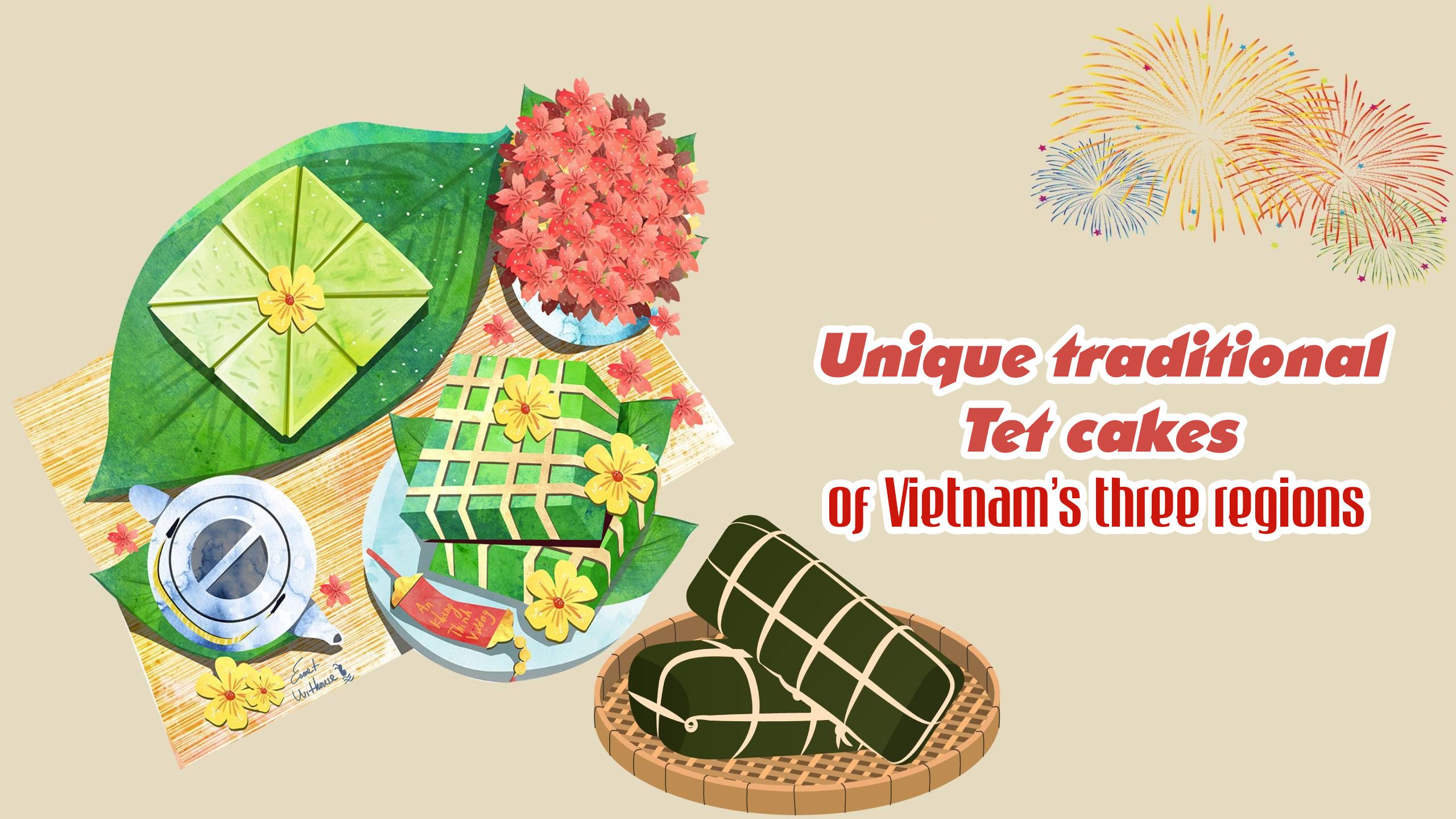
For all Vietnamese around the world, the Lunar New Year (Tet) is always a sacred occasion, when family members set aside daily worries and get together around the Tet meals. And in such meals, traditional cakes are an indispensable part.
While the northerners celebrate Tet with ‘banh chung’, people in the central region welcome the new year with ‘banh to’ and southerners enjoy the occasion with ‘banh tet’.
Amid the festive moodat the arrival of spring, Nhan Dan would like to introduce the traditional cakes of Vietnam’s three regions.
‘Banh chung’ is sticky and fragrant, ‘banh phu the’ is sweet and nutty
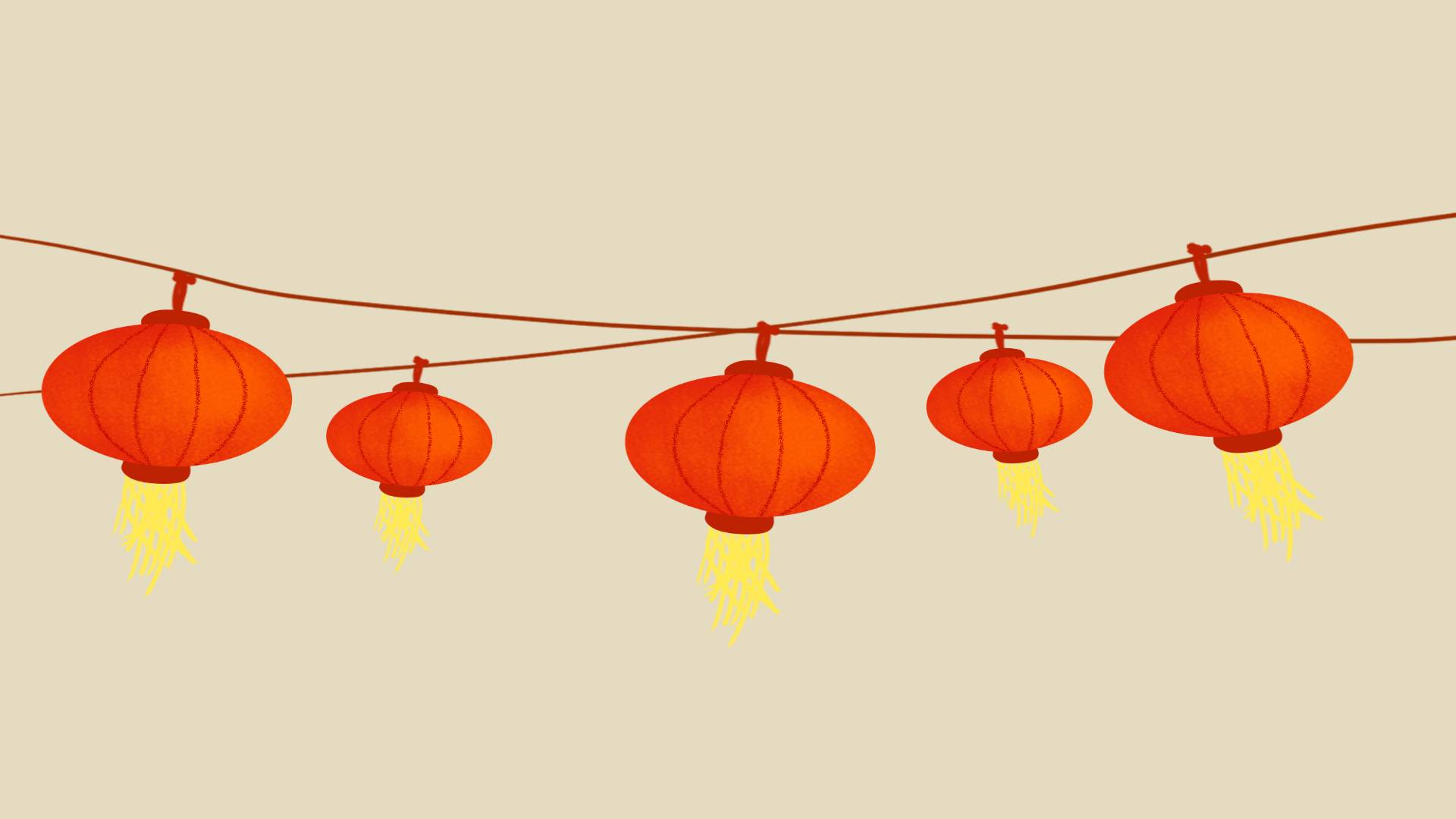
'Banh chung'
The difficult days when food and clothes were scarce are already far past, and ‘banh chung’, which was previously only available during Tet, is now consumed all year round. But the difference is that during Tet, ‘banh chung’will be made in a more elaborate way, as an offering to the ancestors and for everyone to taste the dish, in the most complete way at reunion meals.
Legend has it that the square ‘banh chung’ is wrapped by the green ‘dong’ leaves, which represent the fertile soil of Vietnam’s wet rice agriculture. Inside ‘banh chung’ is sticky, fragrant rice, combined with green beans and fatty pork belly cuts marinated with pepper and other seasonings.
‘Dong’ leaves can be purchased at all markets ahead of Tet. To ensure that ‘banh chung’ is good-looking, the leaves must be green and undamaged. After being bought, the wrapping leaves must be cleaned thoroughly to remove any dust and grit before letting them dry naturally.
A ‘banh chung’ needs about five or six dong leaves, the rice and the filling depends on the size of the cake to be wrapped. To wrap the ‘banh chung’, it is necessary to do steps: Placing the dong leaves at staggered angles, spreading a layer of glutinous rice evenly on the leaf surface, then spreading the green beans evenly over the rice, arranging the marinated pork belly in the middle, and continuing to cover with more layers of green beans and rice, wrapping the leaves in a square, and tie across. It is necessary to hold it firmly and evenly, so that the cake will not be distorted or out of balance. After completing the process of wrapping the cake, the cake will be boiled in a large pot.
‘Banh chung’ is picked up and smoked, left to cool in the cold weather, infiltrated with the taste of heaven and earth, and mixed with the warm and happy atmosphere of generations of Northern families, in the last days of the year.
Boiling cake seems to be simple, but it is the most important step, needing the most meticulousness, because it takes a lot of time and effort. During the seven to ten hours of cooking the cake, it is necessary to have enough heat to keep the water boiling, and not to let the cake pot be short of water, in order to avoid the case where the cake is half cooked or raw. Nowadays, families often boil cakes with charcoal or electric stoves, but cooking with firewood is still the most delicious and soft.
During the Lunar New Year's Day, on the Tet tray to offer to ancestors, as well as at parties on the Lunar New Year holiday of the Northern people, it is indispensable for the image of green ‘banh chung’ with meat and pickled onions.
In recent years, although the economy has been quite prosperous, modern life is busy and ‘banh chung’ are available for sale, many families still maintain the custom of wrapping ‘banh chung’ on Tet, to help their children understand more about the traditions of their ancestors and nation. Although it takes effort, but in return, the moments when the whole family gathers around, will become a precious memory in everyone's life.
‘Banh phu the’
‘Banh phu the’ (husband and wife cake) is also a typical cake during Tet holiday forthe northern people, especially the areas of Bac Ninh - Kinh Bac, the hometown of these cakes. Every Lunar New Year, people get together and prepare delicious cakes, with the wish of a happy and prosperous life.
It is said that the very first ‘banh phu the’ was created hundreds of years ago in Dinh Bang ward, Tu Son city, Bac Ninh province. According to locals, ‘banh phu the’, also known as ‘banh xuxe’ was dated to the Ly dynasty (1009-1225), when King Ly Anh Tong (1136 - 1175) was leading his army on the battlefield, he received a cake box made by his Queen. The cakes tasted sweet and he named them ‘phu the’ cake, to honour the love of married couples.
In another version, legend has it that when King Ly Thanh Tong (1023-1072) and his wife visited the Do Temple Festival, in Bac Ninh province, the King was offered indigenous cakes made by a young married couple in the village. Delighted by the tasty flavour of the cakes, he named them‘banh phu the’. Since then, ‘banh phu the’ has been used in weddings and festivals, as a symbol of the faithfulness and happiness of marriage.
The making of ‘banh phu the’ requires careful selection of ingredients, from sticky rice, green beans, banana leaves, dong leaves, and ‘danh danh’ (cape jasmine) fruits. The outer layer of ‘banh phu the’ is made from ‘nep cai hoa vang’ (a special kind of sticky rice of the north), which is grounded to powder and is then mixed with white sugar, shredded green papaya, banana oil, and vanilla.‘Danh danh’ fruit juice is added into the mixture to create the yellow colour for ‘banh phu the’. Meanwhile, the inside of the cake is made of green beans, which are cooked and blended with white sugar, coconut milk and grated coconut.
Banana leaves and‘dong’leaves are washed and drained. The stalks and midribs of the leaves are removed to make them softer. The inner layer of leaves for wrapping the cakes are banana leaves which must be boiled and let dry. Before wrapping, the cook rubs a thin layer of fat on the leaves so that the cake does not stick when being peeled off. The fat also adds a greasy taste for the cake. After wrapping, the cakes are boiled and taken out to tie into pairs with a pink string,to convey the wish for eternal love of husband and wife.
Every year when cherry blossoms bloom, signalling the arrival of Tet (lunar New Year) festival, locals of Dinh Bang are busy making ‘banh phu the’ for their families and for customers, throughout the provinces and cities across the country. The odour and the viscosity of the cake, plus the crunchiness of shredded green papaya, the greasy taste of green beans and coconut, and the sweetness of sugar, paired with the golden colour of the crust, together they create a very characteristic flavour for ‘banh phu the’. The appearance of ‘banh phu the’ brings about the spring atmosphere to the ancestors' altars and the family meals on Tet holiday.
And for the people of Dinh Bang, making ‘banh phu the’ is to prolong the tradition of the homeland.
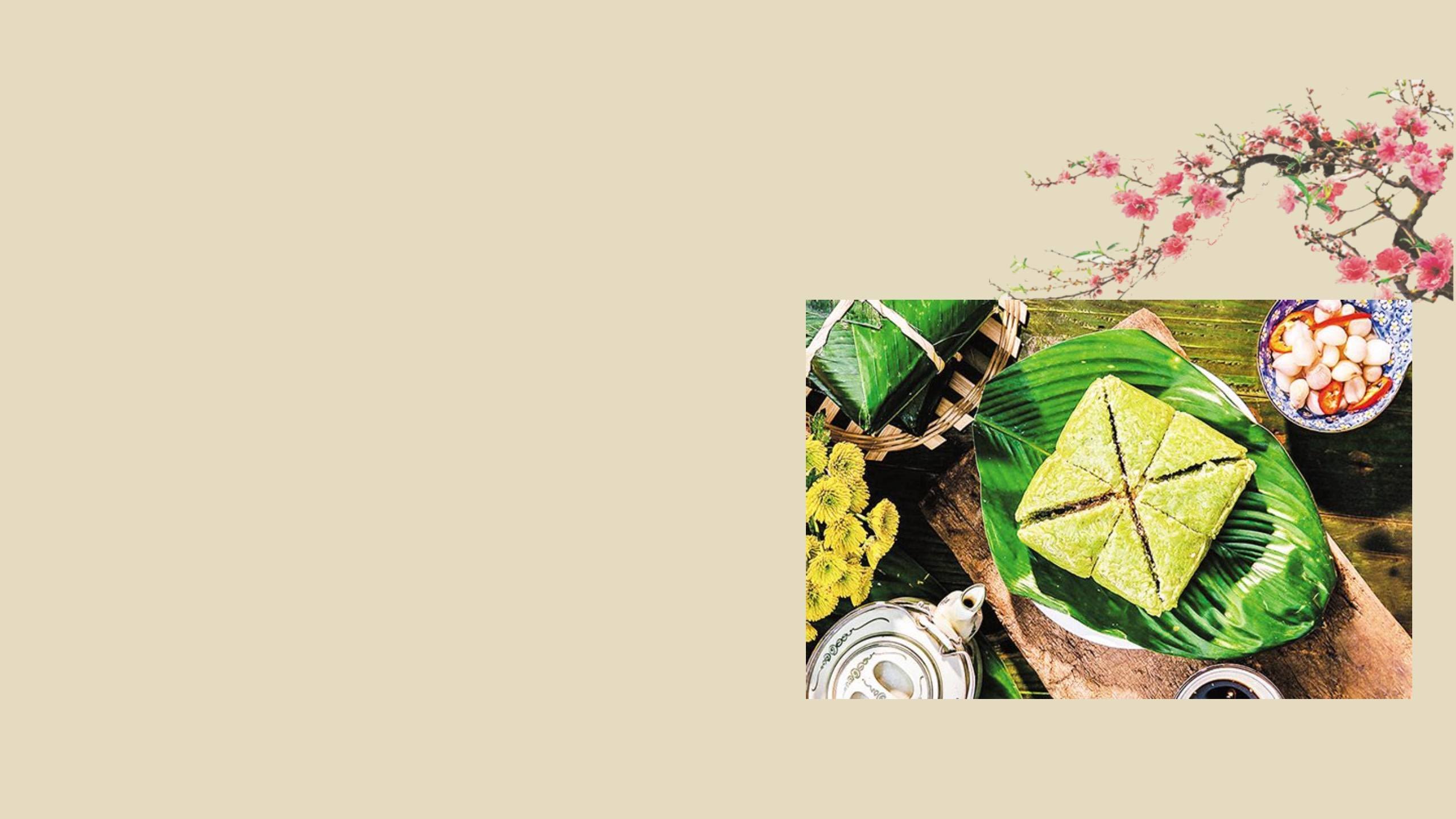

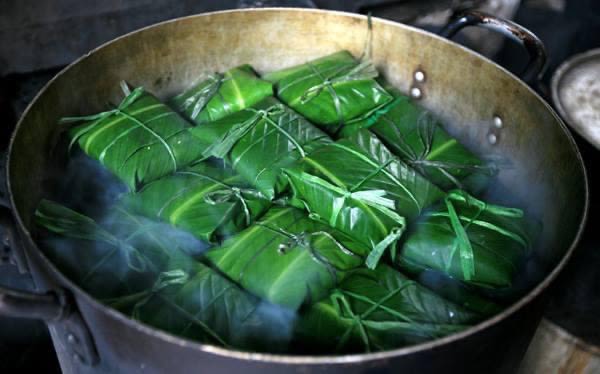
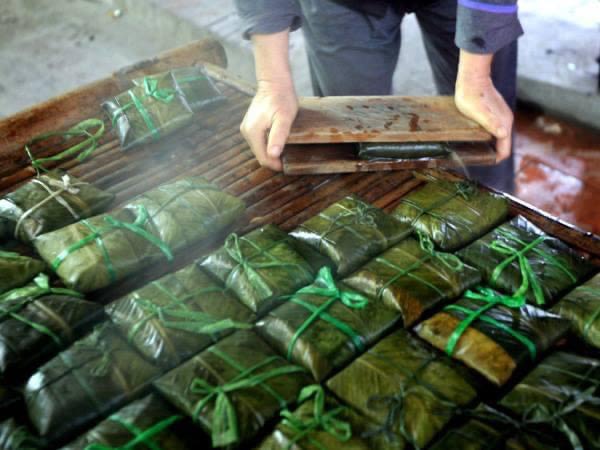



After wrapping, cakes are steamed in a water bath.
After wrapping, cakes are steamed in a water bath.

After cakes are cooked, it will be taken out and then the water squeezed out of them, before being left to dry.
After cakes are cooked, it will be taken out and then the water squeezed out of them, before being left to dry.

When the cakes cool, the baker will wrap them with an extra layer of green dong leaves, then tie them into pairs.
When the cakes cool, the baker will wrap them with an extra layer of green dong leaves, then tie them into pairs.

Yellow, glossy, delicious ‘banh phu the’ will be delivered to customers.
Yellow, glossy, delicious ‘banh phu the’ will be delivered to customers.
The rich taste of ‘banh to’

Cuisine in the Central region is extremely rich and diverse, each dish has its own characteristics. Central specialties from snacks, to traditional Tet dishes or desserts, all have charm and sophistication, in the way of processing, that makes it hard for diners to ignore.
Whenever it comes to delicious dishes from Quang region, people immediately think of Quang noodles, veal of Mong bridge, Tam Ky chicken rice and Hoi An Cao Lau. But in folklore, there are many stories about special dishes: “Hoa Vang spring rolls, Hoi An‘banh to’”. Those are the long-standing traditional dishes in each Lunar New Year’s Eve of the Quang people. However, a delicious and attractive cake that cannot be missed on the ancestral altar of Tet holiday is ‘banh to’.
On the altar on the Lunar New Year’s Eve, not all dishes are offered. For savoury dishes, people only choose a bowl of Quang noodles or a plate of sticky rice, while ‘banh to’ is indispensable.
‘Banh to’ is usually only available on Tet holiday, it will be harder to find on weekdays. The cake is dark brown like the colour of the earth, poured in a thick mould, square or round, which is the symbol of “round heaven and square earth” in the people’s traditional way of thinking.

The process of making ‘banh to’ is not simple, because the cake must be flexible, chewy and sweet. Therefore, glutinous rice flour must be selected from a famous type of glutinous rice in Quang region, then added with sugar and ginger juice. Glutinous flour and sugar are thoroughly kneaded, adding a little ginger juice for aroma. All are mixed together.
Dried banana leaves or dong leaves are wiped clean and lined around the bamboo spokes mould, previously woven into a square or round gabion, with a diameter of 10 to 15cm. Mix the powder and sugar to a smooth consistency, pour it into the mould, and then steam it.

The longer the ‘banh to’ is kept, the stickier and more fragrant the flavour. (Photo: Duong Mai Anh)
The longer the ‘banh to’ is kept, the stickier and more fragrant the flavour. (Photo: Duong Mai Anh)
After the cake is cooked, it is taken out. At this time, the sesame seeds are sprinkled evenly on the surface of the cake and it takes about three to four minutes for the cake to cool, and then it should be stored in a cool place. People can also bring the cake out to dry in the sun. However, a delicious ‘banh to’ is not too hard or too mushy and when being cut, the dough does not stick to the knife. Quang Nam ‘banh to’ can be kept for several days without fear of mould. The longer the cake is kept, the stickier and the stronger the flavour. This also depends on the individual know-how of the baker.
Today, the market is flooded with many kinds of cakes, with beautiful designs and good quality, but ‘banh to’ still holds a very important position for the people of Quang Nam. ‘Banh to’ is not only a delicious food, but also bears a nice traditional culture. Remembering the ‘banh to’ is also remembering the origin of the village.
Banh tet

For generations, on the occasion of the Lunar New Year, Southern families eagerly prepare glutinous rice, green beans, bacon, banana leaves, string and others, to gather together to make ‘banh tet’. The image of ‘banh tet’ has become the “soul of Tet” of the people in the Southern region.
The ‘banh chung’ originated from the 16th Hung King's reign, according to “The legend of banh chung and banh day”, ‘banh tet’ of the Southern people is reminiscent of the talented king Quang Trung. This cake was initially ordered by the King to be made on Tet holiday (Lunar New Year) and named ‘banh Tet’.
The main ingredients to make a ‘banh tet’ are the same as ‘banh chung’ of the Northern region, which are glutinous rice, green beans, and bacon. However, ‘banh tet’ has two differences compared to ‘banh chung’ which is wrapped with banana leaves and has a long round shape.

In order to make delicious‘banh tet’, the ingredients should be prepared meticulously and carefully. Particularly, glutinous rice must be new, fragrant and delicious; peeled green beans are cooked; and desiccated coconuts are grated to get coconut milk. In addition, pandan leavesare ground and filtered the water that will be mixed with the rice to create a cool green colour. Lean and fat meats are cut according to the length of the cake and marinated with several spices as stuffing.
Boiling ‘banh tet’ is similar to‘banhchung’ in terms of placing the cakes in the pot, boiling time and the continuous fire, so that the cakes are not raw or mushy.The moment of cooking ‘banh tet’ is always the most sought aftertime, when all members of the family gather together. Children are also eager to stay awake to watch for the pot and chat with their grandparents and parents about traditional Tet. Therefore, the love and the warmth of the fire, spreads to every corner of the kitchen and the house. Year after year, Vietnamese children grow up like that.
The cooked ‘banh tet’ will be cut into beautiful circles to offer to ancestors after it gets cold. It is also an indispensable dish of southern people on the occasion of Lunar New Year.
Today, ‘banh tet’ is made and eaten all year round, however, it is really meaningful during New Year Festival. Southern mothers make ‘banh tet’ full of love and look forward to their children returning home. ‘Banh tet’ urges people who live far from home to put aside their busy work, to come back home where their mothers are waiting for them.
Spring comes, all streets and roads across all regions of the country are full of apricot flowers, peach blossoms and kumquats. People are busy shopping for Tet holiday. The traditional cakes with familiar ingredients will be top on the list of mothers’ preparations. Each kind of cake has its own flavour, but all highlight the national soul and the mothers’ hearts. They have become the pride of Vietnamese people, as a reminder of the memories of reunions.

Production manager: HONG MINH
Content, Design: PHUNG TRANG, NGOC BICH
Photos: Duong Mai Anh, File Photo
